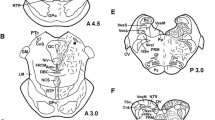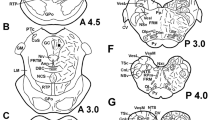Summary
1. We have used biochemical, immunocytochemical, and electrophysiological techniques to evaluate the role of opioid peptides in the central nervous system of the marine mollusc,Aplysia california.
2. Binding studies using3H-d-Ala2, met-enkephalinamide (3H-DAMA) showed a single class of high-affinity binding sites with aK d of 1.3 nM and a binding density of 45 pmol/g.
3. HPLC extracts of ganglia revealed multiple peaks with immunoreactivity for either leu (LEU-IR)- or met-enkephalin (MET-IR), but the amounts were not uniformly distributed in all ganglia.
4. LEU-IR and MET-IR neurons were demonstrated immunocytochemically in all ganglia, but MET-IR neurons were more frequent and were concentrated in pedal and pleural ganglia. While absorption control studies abolished MET-IR, LEU-IR was only partially abolished in the neuropil.
5. In electrophysiological studies, both depolarizing and hyperpolarizing responses were found tod-Ala2-leu-enkephalin (DALEU) andd-Ala2-met enkephalin (DAMET) on some and different neurons.
6. HPLC fractions from regions with retention times corresponding to authentic leu- or met-enkephalin showed physiologic responses similar to those of DALEU and DAMET, respectively.
7. These studies suggest that a variety of endogeneous opioid peptides play physiologically important roles in the nervous system ofAplysia, including but not necessarily limited to leu- and met-enkephalin.
Similar content being viewed by others
References
Carpenter, D. O., and Hori, N. (1992). Neurotransmitter and peptide receptors on medial vestibular nucleus neurons.Ann. N.Y. Acad. Sci. 656668–686.
Crain, S. M., and Shen, K.-F. (1990). Opioids can evoke direct receptor-mediated excitatory effects on sensory neurons.Trends Pharmacol. Sci. 1177–81.
Elekes, K.,et al. (1993). Enkephalin-like immunoreactive neurons in the central nervous system of gastropods (Helix pomatia, Lymnaea stagnalis, Aplysia californica): A comparative immunocytochemical study.Cell Tissue Res. 272329–341.
Florey, E., and Stefano, G. B. (1992).Comparative Aspects of Neuropeptide Function, Pergamon Press, New York.
Frazier, W. T.,et al. (1967). Morphological and functional properties of identified neurons in the abdominal ganglion ofAplysia californica.J. Neurophysiol. 301288–1351.
Gardner, D. (1971). Bilateral symmetry and interneuronal organization in the buccal ganglia ofAplysia.Science 173550–553.
Jahan-Parwar, B., and Fredman, S. M. (1976). Cerebral ganglion ofAplysia: Cellular organization and origin of nerves.Comp. Biochem. Physiol 53A247–357.
Kemenes, G.,et al. (1992). Distinct receptors for leu- and met-enkephalin on the metacerebral giant cell ofAplysia.Cell. Mol. Neurobiol. 12107–119.
Leung, M. K., and Stefano, G. B. (1984). Isolation and identification of enkephalins in pedal ganglia ofMytilus edulis (Mollusca).Proc. Natl. Acad. Sci. USA 81955–958.
Leung, M. K.,et al. (1986). Enkephalin-like substance inAplysia nervous tissue and actions of leu-enkephalin on single neurons.Life Sci. 381529–1534.
Leung, M. K.,et al. (1990). Evidence for an enkephalinergic system in the nervous system of the pond snail,Lymnaea stagnalis.Brain Res. 53166–71.
Lin, Y., and Carpenter, D. O. (1994). Direct excitatory opiate effects mediated by nonsynaptic actions on rat medial vestibular neurons.Eur. J. Pharmacol. 26299–106.
Lowry, O. H.,et al. (1951). Protein measurement with the Folin phenol reagent.J. Biol. Chem. 193265–275.
Paterson, S. J.,et al. (1983). Classification of opioid receptors.Br. Med. Bull. 3931–36.
Pert, C. B.,et al. (1974). Phylogenetic distribution of opiate receptor binding.Brain Res. 75356–361.
Schot, L. P. C.,et al. (1981). Immunocytochemical demonstration of peptidergic neurons in the central nervous system of the pond snailLymnaea stagnalis with antisera raised to biologically active peptides of vertebrates.Cell Tissue Res. 216273–291.
Shen, K.-F., and Crain, S. M. (1989). Dual opioid modulation of the action potential duration of mouse dorsal root ganglion neurons in cultures.Brain Res. 491227–242.
S.-Rózsa, K. (1984). The pharmacology of molluscan neurons.Prog. Neurobiol. 3879–150.
S.-Rózsa, K.,et al. (1991). Characterization of responses to enkephalin and FMRFamide on B neurons of the cerebral ganglion ofAplysia.Comp. Biochem. Physiol. 99C403–412.
Stefano, G. B. (1981). Decrease in the number of high-affinity opiate binding sites during the aging process inMytilus edulis (Bivalvia).Cell. Mol. Neurobiol. 1343–350.
Stefano, G. B. (1989). Role of opioid neuropeptides in immunoregulation.Prog. Neurobiol. 33149–159.
Stefano, G. B., and Martin, R. (1983). Enkephalin-like immunoreactivity in the pedal ganglion ofMytilus edulis (Bivalvia) and its proximity to dopamine-containing structures.Cell Tissue Res. 230147–153.
Stefano, G. B.,et al. (1980). Demonstration of stereospecific opiate binding in the nervous tissue of the marine mollusc,Mytilus edulis.Brain Res. 181440–445.
Stefano, G. B.,et al. (1989). Stimulatory effects of opioid neuropeptides on locomotory activity and conformational changes in invertebrate and human immunocytes: Evidence for a subtype of delta receptor.Proc. Natl. Acad. Sci. USA 868307–6311.
Stefano, G. B.,et al. (1992). (D-Ala2)Deltorphin I binding and pharmacological evidence for a special subtype of delta opioid receptor on human and invertebrate immune cells.Proc. Natl. Acad. Sci. USA 899316–9320.
Stefano, G. B.,et al. (1993). Opiate-like substances in an invertebrate: A novel opiate receptor on invertebrate and human immunocytes, and a role of immunosuppression.Proc. Natl. Acad. Sci. USA 9011099–11103.
Sternberger, L. A. (1979).Immunocytochemistry, 2nd ed., John Wiley and Son, Chichester.
Author information
Authors and Affiliations
Rights and permissions
About this article
Cite this article
Carpenter, D.O., Kemenes, G., Elekes, K. et al. Opioid peptides in the nervous system ofAplysia: A combined biochemical, immunocytochemical, and electrophysiological study. Cell Mol Neurobiol 15, 239–256 (1995). https://doi.org/10.1007/BF02073331
Received:
Accepted:
Issue Date:
DOI: https://doi.org/10.1007/BF02073331




